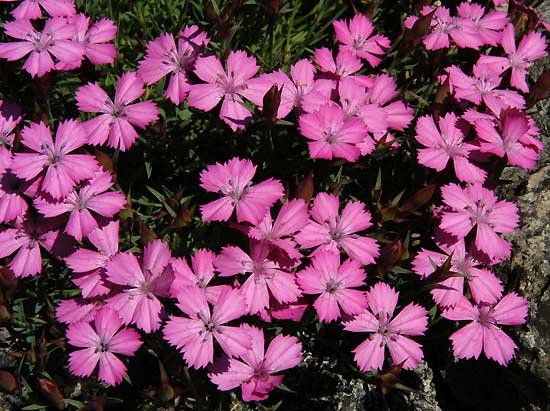
Petrocoptis glaucifolia
Endemic to the limestone cliffs and crags of northern Spain, Petrocoptis glaucifolia is a remarkable rock-dwelling perennial of the carnation family, perfectly adapted to life on sheer stone faces. Its native haunts are vertical walls, ledges, and shady fissures, where roots seek out pockets of thin soil and foliage drapes elegantly over pale rock.
The plant forms loose rosettes and trailing sprays of glaucous, bluish-green leaves that provide an attractive backdrop to its airy clusters of pale pink to white, fringed blossoms. These delicate flowers, borne in late spring to early summer, are visited by small bees and moths in their native habitat, adding movement and life to even the starkest cliff.
In cultivation, P. glaucifolia asks for a sharply drained, lime-rich soil and partial shade to mimic its natural, north-facing cliffs. It is especially suited to crevice gardens, vertical stone walls, and troughs, where its trailing habit can be shown to best advantage as it softens rock with its silvery foliage and light bloom. Hardy to USDA zone 6, it is a durable and surprisingly tough plant when its preference for good drainage and cool roots is respected.
Endemic to the limestone cliffs and crags of northern Spain, Petrocoptis glaucifolia is a remarkable rock-dwelling perennial of the carnation family, perfectly adapted to life on sheer stone faces. Its native haunts are vertical walls, ledges, and shady fissures, where roots seek out pockets of thin soil and foliage drapes elegantly over pale rock.
The plant forms loose rosettes and trailing sprays of glaucous, bluish-green leaves that provide an attractive backdrop to its airy clusters of pale pink to white, fringed blossoms. These delicate flowers, borne in late spring to early summer, are visited by small bees and moths in their native habitat, adding movement and life to even the starkest cliff.
In cultivation, P. glaucifolia asks for a sharply drained, lime-rich soil and partial shade to mimic its natural, north-facing cliffs. It is especially suited to crevice gardens, vertical stone walls, and troughs, where its trailing habit can be shown to best advantage as it softens rock with its silvery foliage and light bloom. Hardy to USDA zone 6, it is a durable and surprisingly tough plant when its preference for good drainage and cool roots is respected.







